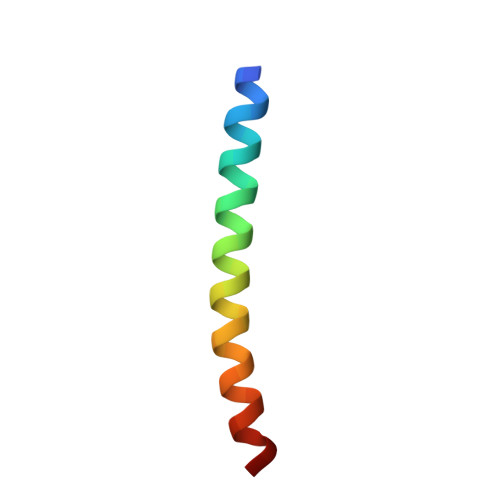Structural and Thermodynamic Analysis of HIV-1 Fusion Inhibition Using Small gp41 Mimetic Proteins.
Jurado, S., Cano-Munoz, M., Morel, B., Standoli, S., Santarossa, E., Moog, C., Schmidt, S., Laumond, G., Camara-Artigas, A., Conejero-Lara, F.(2019) J Mol Biol 431: 3091-3106
- PubMed: 31255705
- DOI: https://doi.org/10.1016/j.jmb.2019.06.022
- Primary Citation of Related Structures:
6R2G - PubMed Abstract:
Development of effective inhibitors of the fusion between HIV-1 and the host cell membrane mediated by gp41 continues to be a grand challenge due to an incomplete understanding of the molecular and mechanistic details of the fusion process. We previously developed single-chain, chimeric proteins (named covNHR) that accurately mimic the N-heptad repeat (NHR) region of gp41 in a highly stable coiled-coil conformation. These molecules bind strongly to peptides derived from the gp41 C-heptad repeat (CHR) and are potent and broad HIV-1 inhibitors. Here, we investigated two covNHR variants differing in two mutations, V10E and Q123R (equivalent to V38E and Q40R in gp41 sequence) that reproduce the effect of HIV-1 mutations associated with resistance to fusion inhibitors, such as T20 (enfuvirtide). A detailed calorimetric analysis of the binding between the covNHR proteins and CHR peptides (C34 and T20) reveals drastic changes in affinity due to the mutations as a result of local changes in interactions at the site of T20 resistance. The crystallographic structure of the covNHR:C34 complex shows a virtually identical CHR-NHR binding interface to that of the post-fusion structure of gp41 and underlines an important role of buried interfacial water molecules in binding affinity and in development of resistance against CHR peptides. Despite the great difference in affinity, both covNHR variants demonstrate strong inhibitory activity for a wide variety of HIV-1 strains. These properties support the high potential of these covNHR proteins as new potent HIV-1 inhibitors. Our results may guide future inhibition approaches.
Organizational Affiliation:
Departamento de Química Física e Instituto de Biotecnología, Facultad de Ciencias, Universidad de Granada, 18071 Granada, Spain.
















